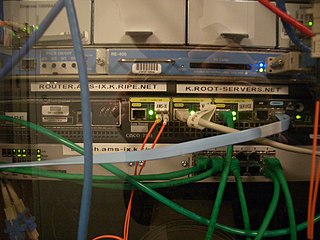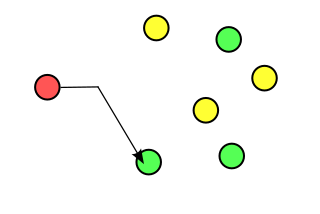Related Research Articles
An Internet Protocol address is a numerical label such as 192.0.2.1 that is assigned to a device connected to a computer network that uses the Internet Protocol for communication. IP addresses serve two main functions: network interface identification, and location addressing.

A root name server is a name server for the root zone of the Domain Name System (DNS) of the Internet. It directly answers requests for records in the root zone and answers other requests by returning a list of the authoritative name servers for the appropriate top-level domain (TLD). The root name servers are a critical part of the Internet infrastructure because they are the first step in resolving human-readable host names into IP addresses that are used in communication between Internet hosts.

Paul V. Mockapetris is an American computer scientist and Internet pioneer, who invented the Internet Domain Name System (DNS).

Anycast is a network addressing and routing methodology in which a single IP address is shared by devices in multiple locations. Routers direct packets addressed to this destination to the location nearest the sender, using their normal decision-making algorithms, typically the lowest number of BGP network hops. Anycast routing is widely used by content delivery networks such as web and name servers, to bring their content closer to end users.
Wireless sensor networks (WSNs) refer to networks of spatially dispersed and dedicated sensors that monitor and record the physical conditions of the environment and forward the collected data to a central location. WSNs can measure environmental conditions such as temperature, sound, pollution levels, humidity and wind.
Distributed denial-of-service attacks on root nameservers are Internet events in which distributed denial-of-service attacks target one or more of the thirteen Domain Name System root nameserver clusters. The root nameservers are critical infrastructure components of the Internet, mapping domain names to IP addresses and other resource record (RR) data.

In computer networking, telecommunication and information theory, broadcasting is a method of transferring a message to all recipients simultaneously. Broadcasting can be performed as a high-level operation in a program, for example, broadcasting in Message Passing Interface, or it may be a low-level networking operation, for example broadcasting on Ethernet.
Chalermek Intanagonwiwat is a computer scientist best known for his work on directed diffusion under the supervision of Deborah Estrin, Ramesh Govindan, and John Heidemann. In 2013 he moved to San Jose, California to work at Cisco Systems, Inc. Intanagonwiwat earned his bachelor's degree in Computer Engineering from King Mongkut's Institute of Technology Ladkrabang in Thailand and pursued his M.S. and Ph.D. degrees in Computer Science at the University of Southern California, USA. He worked as postdoc researcher at Rutgers University, USA. His research interests include computer networks and distributed systems. From 2003 - 2013, he taught in the Department of Computer Engineering, Chulalongkorn University.

Deborah Estrin is a Professor of Computer Science at Cornell Tech. She is co-founder of the non-profit Open mHealth and gave a TEDMED talk on small data in 2013.
David Ethan Culler is a computer scientist and former chair of the Department of Electrical Engineering and Computer Sciences at the University of California, Berkeley. He is a principal investigator in the Software Defined Buildings (SDB) project at the EECS Department at Berkeley and the faculty director of the i4Energy Center. His research addresses networks of small, embedded wireless devices, planetary-scale internet services, parallel computer architecture, parallel programming languages, and high performance communication. This includes TinyOS, Berkeley Motes, PlanetLab, Networks of Workstations (NOW), Internet services, Active Message, Split-C, and the Threaded Abstract Machine (TAM).
Hari Balakrishnan is the Fujitsu Professor of Computer Science and Artificial Intelligence in the Department of Electrical Engineering and Computer Science at MIT, and the Co-founder and CTO at Cambridge Mobile Telematics.

Victor Bahl is an Indian Technical Fellow and CTO of Azure for Operators at Microsoft. He started networking research at Microsoft. He is known for his research contributions to white space radio data networks, radio signal-strength based indoor positioning systems, multi-radio wireless systems, wireless network virtualization, edge computing, and for bringing wireless links into the datacenter. He is also known for his leadership of the mobile computing community as the co-founder of the ACM Special Interest Group on Mobility of Systems, Users, Data, and Computing (SIGMOBILE). He is the founder of international conference on Mobile Systems, Applications, and Services Conference (MobiSys), and the founder of ACM Mobile Computing and Communications Review, a quarterly scientific journal that publishes peer-reviewed technical papers, opinion columns, and news stories related to wireless communications and mobility. Bahl has received important awards; delivered dozens of keynotes and plenary talks at conferences and workshops; delivered over six dozen distinguished seminars at universities; written over hundred papers with more than 65,000 citations and awarded over 100 US and international patents. He is a Fellow of the Association for Computing Machinery, IEEE, and American Association for the Advancement of Science.
Ramesh Govindan is an Indian-American professor of computer science. He is the Northrop Grumman Chair in Engineering and Professor of Computer Science and Electrical Engineering at the University of Southern California.
Lixia Zhang is the Jonathan B. Postel Professor of Computer Science at the University of California, Los Angeles. Her expertise is in computer networks; she helped found the Internet Engineering Task Force, designed the Resource Reservation Protocol, coined the term "middlebox", and pioneered the development of named data networking.
RIPE Atlas is a global, open, distributed Internet measurement platform, consisting of thousands of measurement devices that measure Internet connectivity in real time.
Sensor Media Access Control(S-MAC) is a network protocol for sensor networks. Sensor networks consist of tiny, wirelessly communicating computers, which are deployed in large numbers in an area to network independently and as long as monitor their surroundings in group work with sensors, to their energy reserves are depleted. A special form of ad hoc network, they make entirely different demands on a network protocol and therefore require network protocols specially build for them (SMAC). Sensor Media Access Control specifies in detail how the nodes of a sensor network exchange data, controls the Media Access Control (MAC) to access the shared communication medium of the network, regulates the structure of the network topology, and provides a method for synchronizing.
Venkata Narayana Padmanabhan is a computer scientist and principal researcher at Microsoft Research India. He is known for his research in networked and mobile systems. He is an elected fellow of the Indian National Academy of Engineering, Institute of Electrical and Electronics Engineers and the Association for Computing Machinery. The Council of Scientific and Industrial Research, the apex agency of the Government of India for scientific research, awarded him the Shanti Swarup Bhatnagar Prize for Science and Technology, one of the highest Indian science awards for his contributions to Engineering Sciences in 2016.
Yunhao Liu is a Chinese computer scientist. He is the Dean of Global Innovation Exchange (GIX) at Tsinghua University.

Craig Partridge is an American computer scientist, known for his contributions to the technical development of the Internet.
J. J. Garcia-Luna-Aceves is a Mexican-American computer engineer, currently professor at the University of Toronto's Department of Electrical and Computer Engineering. Until 2023, he was the Distinguished Professor of Computer Science and Engineering at University of California at Santa Cruz UCSC, holding the Jack Baskin Endowed Chair of Computer Engineering, is CITRIS Campus Director for UCSC, and was a Principal Scientist at the Xerox Palo Alto Research Center. He is a Fellow of the IEEE for contributions to theory and design of communication protocols for network routing and channel access and a fellow to AAAS.
References
- ↑ "2014 elevated fellow". IEEE Fellows Directory.
- ↑ "Overview of John Heidemann's research". ResearchGate. Retrieved 21 January 2022.
- ↑ "NeTs-NBD: Maltraffic Analysis and Detection in Challenging and Aggregate Traffic (MADCAT)". About Awards. National Science Foundation. Retrieved 21 January 2022.
- ↑ Bulusu, Nirupama; Heidemann, John; Estrin, Deborah (2000). "GPS-less low cost outdoor localization for very small devices". IEEE Personal Communications. 7 (5). IEEE Personal Communications, October 2000: 28–34. doi:10.1109/98.878533. S2CID 771769.
- ↑ Stuart, S.C. (3 January 2018). "This Is What it Takes to Measure the Internet". PC Magazine. Retrieved 21 January 2022.
Every 11 minutes, Dr. John Heidemann's team "pings" 4 million networks to ascertain if they are live, looking for patterns and outliers. If a nation-state shuts down their country's web access (as Egypt did in 2011) or a hurricane hits, taking out major utilities and communication networks, Professor Heidemann will know what's going on.
- ↑ "Scientists track Internet usage as it pulses across the globe daily". Phys Org. Science X. Retrieved 21 January 2022.
- ↑ "Internet 'sleeps' in some parts of the world". Financial Express. Reuters. Retrieved 21 January 2022.
There are 4 billion IPv4 internet addresses. Heidemann and his team pinged about 3.7 million address blocks (representing about 950 million addresses) every 11 minutes over the span of two months, looking for daily patterns. 'This data helps us establish a baseline for the Internet - to understand how it functions, so that we have a better idea of how resilient it is as a whole, and can spot problems quicker,' Heidemann said.
- ↑ "SIGCOMM Networking Systems Award | acm sigcomm".
- ↑ <https://viterbischool.usc.edu/news/2017/05/john-heidemann-and-student-win-best-paper